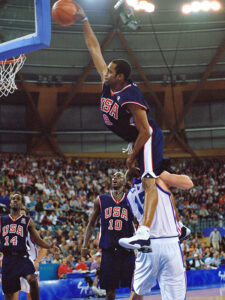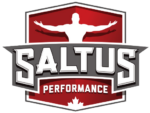BY SEAN DEL BEN, MKIN, CSCS, FMS LVL.2, FRC
Sufficient hip mobility is extremely important for all athletes. Performance training is more than just how heavy, and how fast you can move a weight. Performance training is also about allowing your joints to move in a full range of motion. A combination of pre-requisite mobility, and a high level of stability will allow your body to move the way it should. In this first of two articles on the hips, I am going to focus on hip mobility.
The goal of this article is to provide you with strategies and drills that you can use to improve the function of your hips.
You never know when you may need a little extra hip mobility!

HIP MOBILITY
A study (Iashvili, 1982) concluded that “the level of joint mobility generally relates strongly to sporting proficiency. The higher the level of sporting proficiency, the greater the passive and active flexibility”. A lack of hip mobility will cause a decrease in optimal function at the hips, putting the muscle-tendon system, and overall joint structure at an increased risk of injury.
A concept known as the ‘Joint-by-Joint Approach’, tells us that some joints in the body are meant for stability, while some are meant for mobility (Cook, 2010). The hips are built to be both mobile, and stable. Therefore, a lack of freedom of movement at the hips will cause the knees, and lower back (joints meant for stability) to compensate.
The body works as an integrated kinetic chain, with no postural defects ever being truly isolated. Consequently, a lack of mobility in the hips can lead to structural issues all the way down to the feet and ankles. This unnecessary stress contributes heavily to the high incidence of knee injuries, lower back pain, and ankle injuries in many athletes.
Without the ability of your hip to move with the range of motion required in your chosen sport, the muscles at the hip joint will be unable to generate their full potential of power in actions such as sprinting, sliding, and jumping. For example, if the hip flexors and hip adductors (inner thigh) are tight, your glutes (hip extensors & abductors) will be unable to fully extend and abduct. This will decrease overall speed, and movement efficiency.
HOW TO MOBILIZE YOUR HIPS
When correcting postural issues at the hips, it is important to strike an effective balance between hip mobility and hip stability. You can achieve this by following a proper sequence of developing mobility before stability, and developing passive before active mobility, along with isolated before integrated stability.
It is important to first have the pre-requisite hip mobility prior to developing stability. Stability at the hips can positively affect your ability to develop sufficient mobility. However, to develop stability prior to mobility would be like allowing concrete to set in the wrong mould.
To develop the necessary hip mobility for sport performance, you must ensure you develop a sufficient joint range of motion, tissue length, and muscle flexibility (Cook, 2010). These qualities can be developed by focusing on both an athlete’s passive flexibility, and active mobility.
PASSIVE FLEXIBILITY
Passive flexibility exercises will primarily improve the tissue length of the muscle complex itself. For athletes, active mobility is much more important for sports performance, however sufficient passive flexibility is necessary to provide a ‘buffer zone’ in the event that a joint is unexpectedly pushed beyond its’ normal range of motion as is required in the sport (Siff, 2004). A lack of passive flexibility can also lead to longer recovery times due to decreased circulation of fluids (Ylinen, 2008).
Passive flexibility is typically improved via a slow and constant stretch. This does not require the athlete to use the muscles surrounding the joint to move to achieve the desired stretch. Self-Myofascial Release (via foam rolling etc) may also be needed to help reduce unnecessary tension in the muscle. Developing an athletes’ passive flexibility is necessary when the athlete’s joint range of motion is restricted by the muscle complex itself (Siff, 2004).
Here are a few examples of exercises that can be used to develop an athletes’ passive flexibility in the hips.
ACTIVE MOBILITY
In order to transfer your passive flexibility to movements required in sport, it is important for the athlete to work on their ability to actively move their joints through a full range of motion through use of the muscles surrounding the joint. This is opposed to having an object/person holding the joint in place for them (Tsatsouline, 2001).
It doesn’t matter how much passive flexibility you have if you are too weak to actively move your joint through a full range of motion. Active mobility drills may take place in a supine, half kneeling, quadruped, or standing position. If performed in a standing position, active mobility drills also have the capability of being great for fundamental movement pattern development by simultaneously training the mobility, stability, coordination, and timing necessary for athletic movements. Here are a few examples of exercises that can be used to develop an athletes’ active mobility in the hips.
HOW TO INTEGRATE INTO A PRACTICE OR GAME
Try to avoid passive flexibility work prior to a practice or game. It has become common knowledge that static stretching can be detrimental to an athletes’ speed and explosiveness. However, if an athlete is extremely inflexible, it may impair their fundamental movement patterns. In this case, the athlete will be better off performing some passive flexibility work prior to a more dynamic warm up.
Active mobility drills should be used prior to the athlete stepping foot on the court. After active mobility drills, it will be important for the athlete to begin movement’s specific to what they will experience in game. Simply have the athlete go through a series of movements that would actually occur in a game. Begin with slow movements, and progress to game speed by the end of the warm up. When performing sport specific movements, be sure that your players are focusing on their range of motion and muscles they are using (Siff, 2004).
NEXT STEPS
READ PART 2: Jump Higher & Prevent Injury Part 2 – Hip Stability
Consult with a qualified S&C coach, physiotherapist, or other health care/fitness professional. If you have any questions, please don’t hesitate to e-mail me at [email protected]. If you are in the Vancouver, BC area and are in need of a qualified strength & conditioning coach, we are here to help!.
Resources
Siff, M. (2004) Super Training. Super Training Institute. Denver, CO.
Cook, G. (2010) Movement. On Target Publications. On Target Publications. Santa Cruz, CA.
Iashvili, A. (1982) Active and Passive Flexibility in Athletes Specializing in Different Sports. Teorgiya i Praktika Fizischeskoi Kultury (translated by M Yessis) 7: 51-52
Tsatsouline, P. (2001) Relax Into Stretch. Advanced Fitness Solutions. St. Paul, MN.
Ylinen, J. (2008) Stretching Therapy: For Sport and Manual Therapies. Churchill Livingstone Elsevier
